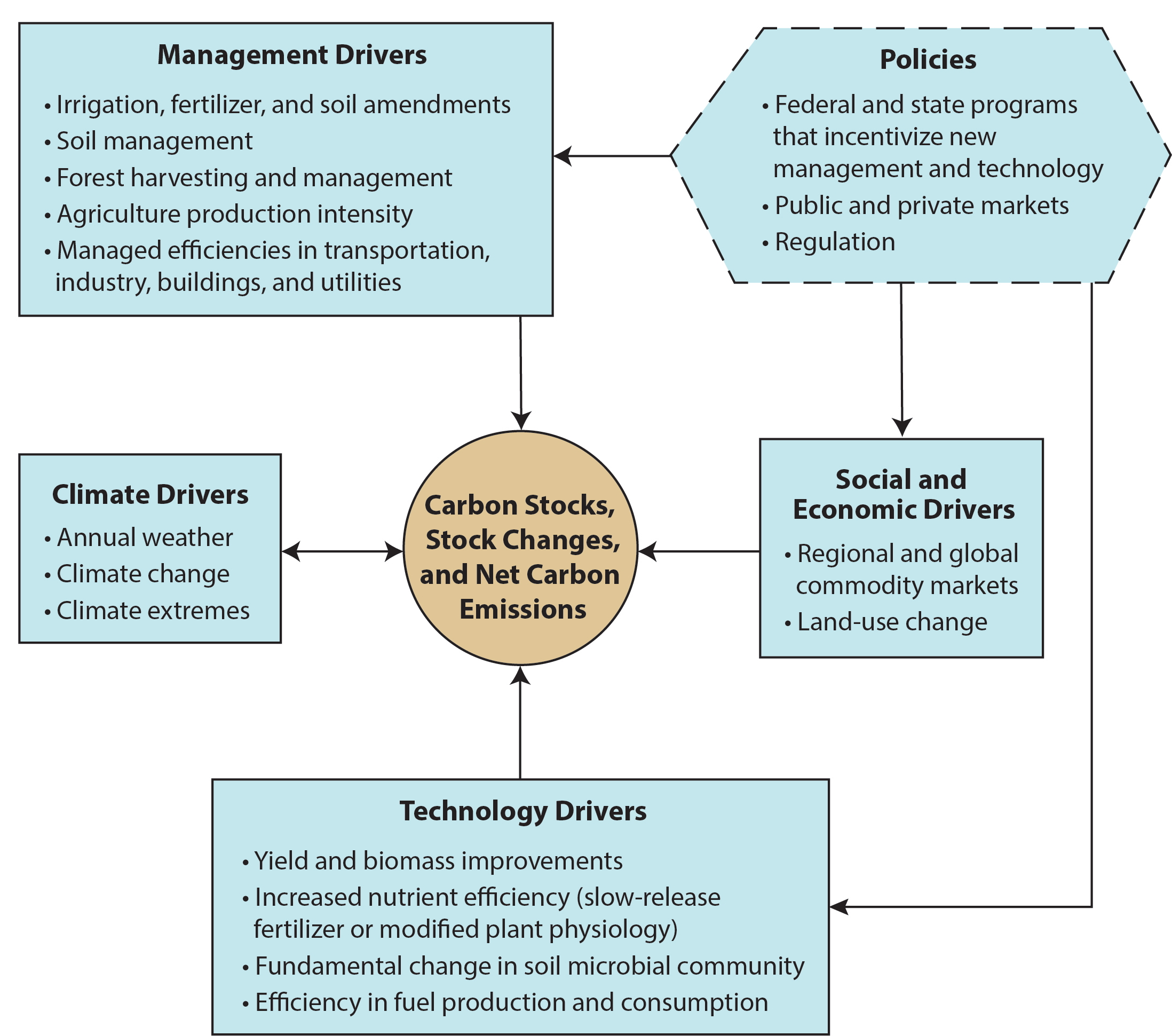West, T. O., N. P. Gurwick, M. E. Brown, R. Duren, S. Mooney, K. Paustian, E. McGlynn, E. L. Malone, A. Rosenblatt, N. Hultman, and I. B. Ocko, 2018: Chapter 18: Carbon cycle science in support of decision making. In Second State of the Carbon Cycle Report (SOCCR2): A Sustained Assessment Report [Cavallaro, N., G. Shrestha, R. Birdsey, M. A. Mayes, R. G. Najjar, S. C. Reed, P. Romero-Lankao, and Z. Zhu (eds.)]. U.S. Global Change Research Program, Washington, DC, USA, pp. 728-759, https://doi.org/10.7930/SOCCR2.2018.Ch18.
Carbon Cycle Science in Support of Decision Making
Recent decades have seen continually increased interest in how best to reduce net carbon emissions, including maintaining or augmenting natural and managed carbon stocks (Griscom et al., 2017) and decreasing anthropogenic carbon emissions. Decisions about carbon management extend from future energy production and technology planning to designs for urban infrastructure and refurbishment; transportation; and agriculture, forest, and natural resource management. Over this same time period, scientists have conducted extensive basic and applied research on biogeochemical cycles, land-cover change, watershed to Earth System Modeling, climate change, and energy efficiency, all of which inform the understanding of the efficacy of various carbon management options (CCSP 2007). However, the information needs of decision makers differ from the objectives that drive basic science to understand natural carbon cycling. Explicitly identifying the information that various decision makers will use, including the form in which they need it, is critical for taking carbon cycle science from laboratory to management action. While much progress has been made in understanding individual components of both fundamental and applied science contributing to decision-making frameworks (see Figure 18.1), additional work is needed to connect these components to address existing research and policy questions.
Figure 18.1: Primary Drivers of Carbon Stocks and Emissions

Methods for connecting and integrating basic and applied carbon cycle research take a number of forms. For example, researchers can 1) simplify complex models to provide mean estimates for given activities (e.g., a complex nitrogen cycle model providing mean and uncertainty estimates for nitrous oxide [N2O] emissions); 2) interpret biogeochemical model results to estimate net carbon flux associated with particular activities (e.g., natural disturbance contributions to global carbon fluxes versus net emissions associated with the management of natural disturbances); or 3) aggregate and analyze scientific data in a different manner to address specific questions (e.g., national emissions estimates versus attribution of net emissions associated with particular activities). These approaches to connect basic science and decision making have most often been employed post hoc, harvesting results from foundational research that already has been conducted to inform decisions, rather than designing and organizing large research programs around user-defined information needs (Lemos and Morehouse 2005). Post hoc methods often are used to synthesize, and sometimes simplify, fundamental research findings for common applications and decision making, including in the Intergovernmental Panel on Climate Change’s (IPCC) 2006 Guidelines for National Greenhouse Gas Inventories (IPCC 2006) and the U.S. Department of Agriculture’s (USDA) Methods for Entity-Scale Inventory (USDA 2014).
While organizations make decisions with whatever information they have available, multiple, competing interests are generally at play in setting priorities, so the quality and credibility of information can influence decisions about carbon management. Some decisions about carbon cycle management require only coarse-level estimates or discipline-specific knowledge, while others benefit from more nuanced analysis or multidisciplinary research. Multidisciplinary research is particularly needed to inform economy-wide carbon management targets (e.g., to maintain atmospheric carbon dioxide [CO2] within a safe operating space for humanity; Rockstrom et al., 2009) and to understand links among sectors (e.g., soil carbon in the land sector associated with biofuel production in the energy sector). Collaborations between scientists and practitioners increase the chances that information intended to inform decisions is actually needed and delivered in a highly useful manner. For decisions affecting multiple sectors, collaborations among scientists of many disciplines tend to produce knowledge that is more credible and practical in the eyes of multiple stakeholders compared to knowledge produced in more siloed environments (Weaver et al., 2014). Although collaborations have increased (Mooney et al., 2013), there remain lost opportunities for effective carbon cycle management that could be captured via more integration.
Federal, state, and local policymakers; company executives; energy managers; urban designers; natural resource managers; families; and individuals make short- and long-term decisions that can influence the carbon cycle. These entities require adequate information from science-based analyses to inform their choices and to understand how management, technologies, or behavioral decisions can affect net carbon emissions or carbon stock changes. Meanwhile, scientists are developing more sophisticated monitoring, data interpretation, and modeling methods that could be relevant to these decision makers, providing more refined understanding. An important but challenging part of carbon cycle science is ensuring that scientists have sufficient understanding of decision makers’ needs to produce information that actually is usable by decision makers and that funding organizations place sufficient priority on actionable science. To facilitate strategic, effective use of carbon cycle science in carbon management, as well as to provide insights about the opportunities and constraints that shape the availability of user-driven carbon cycle science now and in the future, this chapter provides information on national and international needs for carbon cycle information, current status of research to inform carbon cycle and greenhouse gas (GHG) management, and future needs. It also focuses on the sectors of agriculture, forestry, and other land uses (AFOLU) and discusses energy and associated carbon sources in the context of integrated carbon cycle systems.
See Full Chapter & References